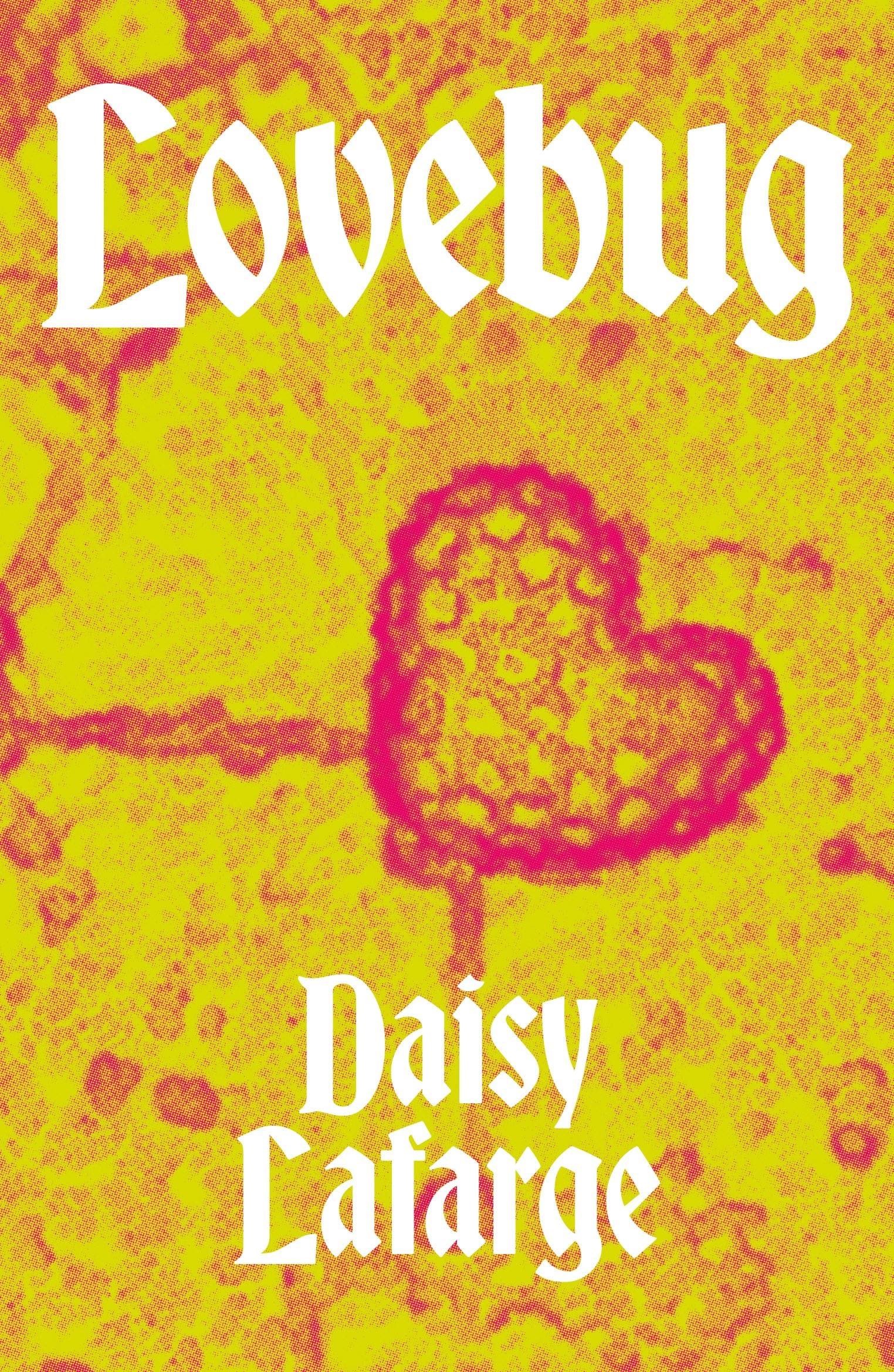If describing Lovebug, the latest from the writer Daisy Lafarge, as a book about intimacy, infection and vulnerability feels a little vague, consider this vagueness a testament only to the difficulty of capturing it in its fullness. Skipping across genres, the book started as Lafarge’s PhD thesis. But, in keeping with her fluid approach to writing itself (Lafarge is both a published novelist and poet), it evolved to become something more expansive and uncontained; a little like a pathogen.
Bringing together microbiology, psychoanalysis and Lafarge’s own experience, from its very opening pages Lovebug is in lively dialogue with both science and its literary influences; Susan Sontag, John Donne, Julia Kristeva and Simone Weil among them. Lafarge describes Anahid Nersessian and Gillian Rose in particular as, “The two models I had, the angels on my shoulder, while I was writing the book.”
Lovebug is a study of the simultaneous terror and beauty of living, as well as of the necessity of language: “not because it is useful,” Lafarge writes. “But because it is luxurious”. “I believe that metaphor isn't this decorative, frilly thing that is added on to language as a bonus or an extra,” she says. “Instead, it’s completely integral to the way that we think and it structures our perception of reality.”
Below, Daisy Lafarge tells AnOther about Lovebug.

Holly Connolly: Lovebug opens, “This book is an exercise in abjection.” Later, you refer to Julia Kristeva’s definition of abjection as, “the violence of mourning for something that has already been lost”. I wanted to start by asking what you mean by ‘an exercise in abjection’?
Daisy Lafarge: I use ‘abjection’ as a deliberately ambiguous word, and I tried to take it in different directions in the book. There’s a surface level where I’m talking about abjection as related to infection, with the abject associations of infectious growth; open wounds, disease, this sense of the body being invaded by nasty entities. Then I was interested in using Kristeva’s understanding of abjection to trouble that. Because the idea of something being already lost, in relation to infection, made me realise that what you think you’re losing with infection was never really had to begin with – this idea that the body has a kind of inviolable integrity, or coherence, a clear divide between self and non-self.
Then also, there are moments in Lovebug where I’m playing with a confessional mode, with romantically or emotionally abject subject matter. But it also resists the confessional at the same time, because it never really gives the full story, or a narrative arc, which is the satisfaction that we often want, or think we want, from confessional writing.
HC: I felt that in the book you wove memoir through quite deftly, while at the same time contesting the very idea of memoir. At one point you write: “I can write about these things, but what I feel I am writing into is the gap between what happened and the words that inadequately fix it here.”
DL: The original version of this book contained none of the memoir! It was more impersonal, because I was writing for an academic context, and with academic writing there’s a presupposition that the author doesn’t have to explain their interests or investments. I didn’t look at the manuscript for a few years, and then when I came back to it, I felt that I needed to try and unpick some of my investments and do an associative, intuitive rewriting. I would read through a section and go about my life for a few days, and then come back to it and add in what had come to mind. I was consciously thinking of narrative and personal narrative as a form of seduction, as an interruption to, and awkward coexistence with, the subject matter of the book. I’m suspicious of memoir as a marketable genre so it felt quite exciting to flirt with it in this illicit way, where you have to read through descriptions of parasites in order to get to the parts that feel more familiar as memoir. The writing and rewriting process often felt like smuggling different genres under the guise of each other.
“I’m suspicious of memoir as a marketable genre so it felt quite exciting to flirt with it in this illicit way” – Daisy Lafarge
HC: Lovebug is bookended by two prose poems, and you write: “Writing as someone who is known to have written poems means that my prose is at risk of being described as lyrical or poetic.” I’m interested in the way you move between genres as a writer, and in the book’s relationship to poetry.
DL: I feel it is really close to poetry, in the sense that I was trying to approach writing it in the way that I would approach writing a poem. That is, there might be bits of research or things that I’ve read floating around my head, but I’m not trying to order them through an argument or plan it in advance. There’s a quote I love by Mary Ruefle where she describes metaphor as, “The philosophy that everything in the world is connected.” Lovebug for me attempts an extended metaphor or metaphysical conceit.
In John Donne’s poems a metaphysical conceit works to bring together two things that don’t have any obvious relation, which become somehow melded in the poem, and accrue into an image that has its own weird logic. I wanted to try and do something similar in prose, melding together infection with the concept of intimacy. Lovebug contains a lot of scientific material but it’s a very unscientific book, partly because it felt important to not uphold science’s claims to objectivity and truth. My research process was thorough, but in writing and rewriting I felt I needed to be playful and take risks.
HC: Some of the writers you reference, in particular Gillian Rose and Hervé Guibert (and arguably Simone Weil, if we subscribe to the idea that she had anorexia), were writing against the clock of their own illnesses, and this also becomes part of the tension of their work. How do you think your own experience of illness might have informed Lovebug?
DL: When I started working on this whole research project, which goes back to 2016, I wasn’t aware of myself as physically ill. So I had this slightly more distanced interest in infection as a topic. Then as I was writing it I was becoming ill, partly with an acquired illness, but also becoming more debilitated by an underlying connective tissue disorder. I’m at the point now where I can’t sit at a desk for more than two or three hours a day, and I have to train my body to be able to do that, almost like you would train for a marathon. So for me writing has a physical cost, and I think that gives it a sense of urgency, possibly to its detriment; what I do has to matter. Which is not to say that writing is self-help, because I don’t find that it works like that, but it’s how I can work through concepts like ambivalence, or coexist with the idea of not getting better.
“Lovebug contains a lot of scientific material but it’s a very unscientific book, partly because it felt important to not uphold science’s claims to objectivity and truth” – Daisy Lafarge
HC: One of my favourite aspects of this book is your acknowledgment of the fact that sometimes we are drawn to situations, especially romantic ones, because they are bad for us. You write: “there was something libidinally thrilling about being destroyed in such a blatant way.”
DL: I think that was partly a reaction to how people discuss things like attachment styles, needing to cut out ‘toxic’ people and setting boundaries. As a set of vocabulary these terms have a strange crossover with the language of infection and contagion. I don’t really believe there is such a thing as risk-free love, and similarly in the context of immunity there’s also no risk-free way of being a body, even if you’re considered healthy and able-bodied.
I think I wanted to explore how vulnerability entails risk, but also how vulnerability, as well as containing the possibility of harm, is also on the side of life, connection and change. Mystical unions come up a lot in the book, and Bataille’s writing on limit-experiences, because I was interested in models of intimacy that involve a degree of destruction or damage, but which aren’t considered wholly negative. I think this has a lot of overlap with romance, and the vocabulary is a lot more interesting.
HC: Lovebug has a close relationship to psychoanalysis. There was a quote I loved from Jaqueline Rose in a recent interview: “Psychoanalysis brings to light everything we don’t want to think about. If you can acknowledge the complexity of your own heart then you’re not going to look for scapegoats.” It made me think, in a very literal way, of your interest in disease, infection and pathogens.
DL: When I first started trying to think about the subject of infection psychoanalytically – and as a caveat I should say I don’t have any psychoanalytic qualification, so this is all very much amateur work by someone in analysis, and invested in it as a method – but at first I thought, this is a really ridiculous thing to be doing. Then, the more I allowed myself to do it, it just seemed really ripe for it. Infection is a perfect thing to scapegoat because it’s invisible, and you can use it to further scapegoat particular ‘germ-carrying’ people to match your prejudices.
But it’s interesting in terms of projection too, because projection is often ‘not real’ and to do with your own neuroses or anxieties, whereas in the case of infection, the actual infection is real. So it’s both literal and metaphorical, or the distinction is unclear, and I think that’s something I’m always very drawn to, from a poetic point of view as well: Is this metaphorical? Or is this literal? Or can it be both? When it’s both that’s when I get interested, because it can’t be dismissed as one or the other, and instead has to be this strange cohabiting thing that exists in both real and unreal dimensions.
Lovebug by Daisy Lafarge is published by Peninsula Press, and is out now.
